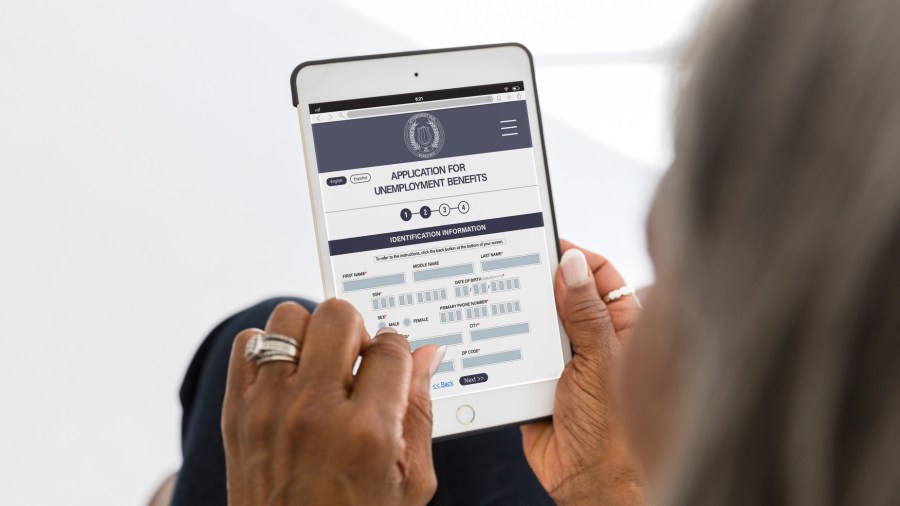
Due to the COVID-19 pandemic, unemployment rates rose sharply in the United States in the spring of 2020. By the end of April, a staggering 30 million Americans had filed for unemployment benefits. Even worse, months later, many jobless people were still desperately trying to cut through all the red tape and the massive volume of people to file their own unemployment claims. Since those early days of chaos, most states have adapted and made improvements to handle all the claims. If you’re wondering how to file a claim after all the changes, we can help you figure it out.
To qualify for unemployment, an individual who lost their job must be eligible for work, able to work and actively seeking employment. Without a doubt, the ongoing pandemic throws a bit of a wrench into the process of actively seeking work, so that component may vary from state to state and could change at any time. Texas, for example, waived their work search requirement for many months but reinstated it on November 1. If you lost your job due to the pandemic or other reasons, here are the steps to take next to file an unemployment claim online.
Step 1: Contact Your State Unemployment Agency
Whether you were laid off because of the pandemic or lost your job due to other unforeseen circumstances, filing for unemployment benefits is one way to cover a portion of your monthly bills while you’re between jobs. Depending on the state you reside in, you will be eligible to apply for unemployment benefits online, in person, on the phone or by mailing in a claim form.

After you’ve lost your job, contact your state unemployment agency as soon as possible. In most cases, you will file a claim with the state where you most recently worked, but if you recently relocated from another state, that may not be the case. Long story short, where you’re currently residing might not be the state that will pay you unemployment benefits if you haven’t lived there long. The state agency will provide guidance on that as well as any other issues that could impact your claim.
Step 2: Determine Your Eligibility
As stated earlier, you need to meet certain criteria in order to be eligible for unemployment benefits. In some cases, people who were fired, suspended or asked to take a leave of absence don’t qualify for unemployment. It depends on the reason you were fired, and the rules vary by state. Moreover, if you willingly quit your job, are an independent contractor or otherwise self-employed, or can’t go back to work for health or other reasons, you might not qualify. (Exceptions are currently in place to qualify independent contractors and the self-employed, but those rules expire at the end of 2020.)

Each state has different compliance requirements with respect to minimum wages and working hours, so we recommend consulting your state’s unemployment agency for details. Additionally, if your application is denied for any reason, you have the right to file an appeal to try to overturn the denial.
Step 3: Verify Your Identity
During the initial application process, each state’s unemployment division will ask you to verify and authenticate your identity. These steps may take place as you’re filing your application, or they could be the last steps in determining your eligibility. Set up email notifications, if possible, and watch closely for any messages requesting additional information. These types of requests are typically very time sensitive.

In some cases, an unemployment official will interview you to clarify and verify details regarding your case and your identity. If you fail to answer the questions correctly — or don’t consent to this process — you will most likely be asked to provide the agency with documents that verify your identity.
Step 4: File Your Claim
Once you confirm your eligibility, it’s time to file your claim. Nearly all unemployment agencies accept claims online, especially in light of the COVID-19 pandemic. The online process isn’t just helpful for pandemic safety reasons. Virtual systems also reduce errors and speed up the claim process.

When you file your claim, you will be asked for some personal information, including your name, address(es), social security number (SSN), last 18 months of employment history, a record of wages earned and the reason and dates for your employment termination. If you want to make sure your claim isn’t delayed, be sure to complete all the sections fully and accurately. Finally, keep in mind that unemployment benefits are taxable, so it’s generally wise to choose to have taxes withheld from each payment when you first open your claim.
Step 5: Collect Your Unemployment Benefits
Most claims are processed within two to three calendar weeks or 10 business days, although delays could occur during times of high claim volumes. Several states conduct telephone interviews before the final ruling to help prevent potential unemployment insurance fraud. During this interview, you will be asked specific questions about your employment background and other information mentioned in your claim.

Once your claim has been processed, you will need to make an appointment at your nearest American Job Center for your state or set up an account online. These state-run agencies give people access to job listings and career training resources, and registration is mandatory to receive your unemployment insurance benefits. If you have any difficulty locating your local center, contact your state unemployment agency for assistance. While you may be breathing an initial sigh of relief once your initial claim is processed, be sure to maintain your eligibility status by continuing your job search as directed.
Step 6: File Your Weekly Payment Request and Keep Up the Job Search
Once you start receiving unemployment benefits, you have to file weekly or biweekly (varies by state) payment requests online to be paid — no exceptions. You’ll be required to answer some questions about any work you completed each week as well as any other income you received. If you fail to file your weekly claim, your benefits may be delayed or stopped altogether.

Finally, it’s important to keep in mind that unemployment benefits are usually contingent upon a recipient doing their part to actively look for a new job. Although this rule may vary by state at times due to special circumstances (like a global pandemic), the general rule of thumb is that you’re expected to pursue work leads every week and report your work search efforts in your weekly claim.
Do you have COVID-19-specific questions about unemployment benefits and stimulus checks? Our peers over at Ask.com have the answers.





